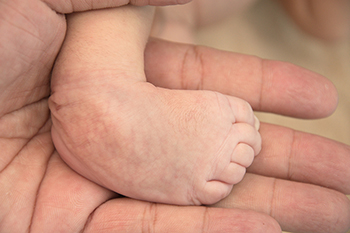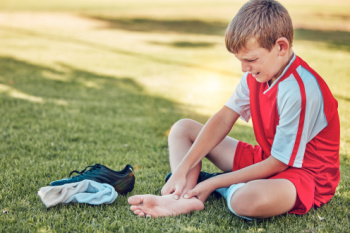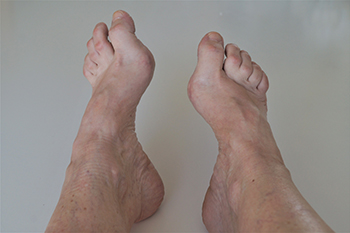Connect With Us
Blog
Items filtered by date: May 2024
Wounds That Don't Heal Need to Be Checked
Selecting the Right Footwear for Restaurant Workers

Choosing the right shoes for restaurant workers is essential for their comfort, safety, and overall performance in a fast-paced environment. When selecting footwear, prioritize shoes that offer slip resistance to prevent accidents on wet or greasy surfaces commonly found in kitchens and dining areas. Look for styles with durable, non-slip soles that provide reliable traction. Additionally, opt for shoes with reinforced toes and sturdy construction to protect against dropped objects and other workplace hazards. Comfort is just as important, as restaurant workers spend long hours on their feet. Look for shoes with ample cushioning and arch support to reduce foot fatigue and minimize the risk of injuries like plantar fasciitis. Consider choosing shoes made from breathable materials to keep feet cool and dry during busy shifts. By prioritizing slip resistance, comfort, and breathability, restaurant workers can find the perfect footwear to support them through demanding shifts. If you have developed foot conditions from wearing the wrong shoes while working, it is suggested that you visit a podiatrist. This foot doctor can offer effective treatment solutions and guide you on how to find the right shoes for your workday.
Finding a properly-fitting shoe is important in reducing injuries and preventing foot problems. For more information about treatment, contact Philip K. Schrumpf, DPM from Active Feet Clinic. Our doctor will treat your foot and ankle needs.
Proper Shoe Fitting
A common concern when it comes to foot health, having properly fitted shoes can help prevent injuries to the foot. Out feet affect our posture and gait, which in turn affects the biomechanics and overall bodily structure. With 33 joints, 26 bones, and over 100 ligaments, the potential for serious injury is much greater than one realizes. Although the feet cease growth in adulthood, they still change shape as they mature. Here are some factors to consider when it comes to investing in proper fitting shoes:
- Be sure the shoes fit correctly right away
- Ensure the ball of your foot fits comfortably in the widest portion of the shoes
- Even though they may look fashionable, improper fitting shoes can either create adverse conditions or exacerbate existing ones you may already have
- Walk along a carpeted surface to ensure the shoes comfortably fit during normal activity
Keeping in mind how shoes fit the biomechanics of your body, properly-fitting shoes are vitally important. Fortunately, it is not difficult to acquire footwear that fits correctly. Be sure to wear shoes that support the overall structure of your body. Do your feet a favor and invest in several pairs of well-fitted shoes today.
If you have any questions please feel free to contact our office located in Missoula, MT . We offer the newest diagnostic and treatment technologies for all your foot and ankle needs.
Managing Clubfoot

Clubfoot, a condition present at birth, can cause challenges as your child grows. Clubfoot is recognized by inward and downward foot placement, sometimes leading to differences in leg sizes. Clubfoot is typically diagnosed shortly after birth and affects about one in every 1,000 births, with boys affected more often than girls. This condition puts strain on the Achilles tendon, which connects the calf muscle to the heel. Treatment often involves gentle manipulation and therapy to help the foot develop normally. If left untreated, it can lead to difficulty walking and discomfort. Seeking early help from a podiatrist is important for managing clubfoot effectively and ensuring a healthier future for your child. In addition to Achilles tendon strain, other symptoms may arise, including pain, rigid leg movements, and difficulties with balance and sleep. Severe cases may require surgery, while milder cases can often be managed with braces and therapy. For help in managing clubfoot in your child, it is suggested that you schedule an appointment with a podiatrist.
Congenital foot problems require immediate attention to avoid future complications. If you have any concerns, contact Philip K. Schrumpf, DPM of Active Feet Clinic. Our doctor can provide the care you need to keep you pain-free and on your feet.
Congenital foot problems are deformities affecting the feet, toes, and/or ankles that children are born with. Some of these conditions have a genetic cause while others just happen. Some specific foot ailments that children may be born with include clubfeet, polydactyly/macrodactyly, and cleft foot. There are several other foot anomalies that can occur congenitally. What all of these conditions have in common is that a child may experience difficulty walking or performing everyday activities, as well as trouble finding footwear that fits their foot deformity. Some of these conditions are more serious than others. Consulting with a podiatrist as early as possible will help in properly diagnosing a child’s foot condition while getting the necessary treatment underway.
What are Causes of Congenital Foot Problem?
A congenital foot problem is one that happens to a child at birth. These conditions can be caused by a genetic predisposition, developmental or positional abnormalities during gestation, or with no known cause.
What are Symptoms of Congenital Foot Problems?
Symptoms vary by the congenital condition. Symptoms may consist of the following:
- Clubfoot, where tendons are shortened, bones are shaped differently, and the Achilles tendon is tight, causing the foot to point in and down. It is also possible for the soles of the feet to face each other.
- Polydactyly, which usually consists of a nubbin or small lump of tissue without a bone, a toe that is partially formed but has no joints, or an extra toe.
- Vertical talus, where the talus bone forms in the wrong position causing other bones in the foot to line up improperly, the front of the foot to point up, and the bottom of the foot to stiffen, with no arch, and to curve out.
- Tarsal coalition, when there is an abnormal connection of two or more bones in the foot leading to severe, rigid flatfoot.
- Cleft foot, where there are missing toes, a V-shaped cleft, and other anatomical differences.
- Macrodactyly, when the toes are abnormally large due to overgrowth of the underlying bone or soft tissue.
Treatment and Prevention
While there is nothing one can do to prevent congenital foot problems, raising awareness and receiving neonatal screenings are important. Early detection by taking your child to a podiatrist leads to the best outcome possible.
If you have any questions please feel free to contact our office located in Missoula, MT . We offer the newest diagnostic tools and technology to treat your foot and ankle needs.
Explaining Kohler’s Disease in Children

Kohler disease, though rare, can cause distress for both you and your child. This bone disorder is characterized by pain and swelling in the foot, often resulting in a limp and pain during walking. While Kohler disease primarily affects boys aged three to seven, girls can also be affected. It is less frequent in girls, however, with typically only one foot being involved, which leads to a preference for walking on the side of the foot. The exact cause of Kohler disease is uncertain. Stress-related compression during critical growth periods and delayed bone formation are thought to be related to its development. The tissue destruction takes place in the navicular bone of the foot due to compromised blood flow, resulting in pain and discomfort. A podiatrist can order X-rays of the navicular bone to identify any such abnormalities. Treatment options include pain management and supportive measures, such as weight-bearing casts or special shoes. Fortunately, Kohler disease may resolve on its own within six months to two years. Even so, early intervention to alleviate discomfort and support natural healing is encouraged. If your child is limping, or otherwise exhibits symptoms that signal pain, it is suggested that you schedule an appointment with a podiatrist for a full exam, diagnosis, and treatment options.
Making sure that your children maintain good foot health is very important as they grow. If you have any questions, contact Philip K. Schrumpf, DPM of Active Feet Clinic. Our doctor can provide the care you need to keep you pain-free and on your feet.
Keeping Children's Feet Healthy
Having healthy feet during childhood can help prevent medical problems later in life, namely in the back and legs. As children grow, their feet require different types of care. Here are some things to consider...
Although babies do not walk yet, it is still very important to take care of their feet.
Avoid putting tight shoes or socks on his or her feet.
Allow the baby to stretch and kick his or her feet to feel comfortable.
As a toddler, kids are now on the move and begin to develop differently. At this age, toddlers are getting a feel for walking, so don’t be alarmed if your toddler is unsteady or ‘walks funny’.
As your child gets older, it is important to teach them how to take care of their feet.
Show them proper hygiene to prevent infections such as fungus.
Be watchful for any pain or injury.
Have all injuries checked by a doctor as soon as possible.
Comfortable, protective shoes should always be worn, especially at play.
If you have any questions please feel free to contact our office located in Missoula, MT . We offer the newest diagnostic and treatment technologies for all your foot and ankle needs.
Problems and Treatment of High Foot Arches

The arch of the foot is essential for supporting weight and movement, but high arches can lead to various issues. Identifying high arches can be done through methods like the wet footprint test or medical evaluation by a podiatrist. Problems associated with high arches include plantar fasciitis, metatarsalgia, claw toes, and hammer toe. Foot and ankle instability, often stemming from altered walking patterns and increased pressure, may also be the result of high arches. Custom orthotic devices, and wearing specialized shoes can offer relief. In severe cases, surgical intervention may be needed to enhance foot stability. A podiatrist can conduct a thorough examination and determine the appropriate treatment options. To correct foot problems brought on by high arches, it is suggested that you schedule an appointment with a podiatrist.
If you have any concerns about your feet, contact Philip K. Schrumpf, DPM from Active Feet Clinic. Our doctor can provide the care you need to keep you pain-free and on your feet.
Biomechanics in Podiatry
Podiatric biomechanics is a particular sector of specialty podiatry with licensed practitioners who are trained to diagnose and treat conditions affecting the foot, ankle and lower leg. Biomechanics deals with the forces that act against the body, causing an interference with the biological structures. It focuses on the movement of the ankle, the foot and the forces that interact with them.
A History of Biomechanics
- Biomechanics dates back to the BC era in Egypt where evidence of professional foot care has been recorded.
- In 1974, biomechanics gained a higher profile from the studies of Merton Root, who claimed that by changing or controlling the forces between the ankle and the foot, corrections or conditions could be implemented to gain strength and coordination in the area.
Modern technological improvements are based on past theories and therapeutic processes that provide a better understanding of podiatric concepts for biomechanics. Computers can provide accurate information about the forces and patterns of the feet and lower legs.
Understanding biomechanics of the feet can help improve and eliminate pain, stopping further stress to the foot.
If you have any questions please feel free to contact our office located in Missoula, MT . We offer the newest diagnostic and treatment technologies for all your foot and ankle needs.
Plantar Warts Can Be Treated!
Blog Archives
- August 2024
- July 2024
- June 2024
- May 2024
- April 2024
- March 2024
- February 2024
- January 2024
- December 2023
- November 2023
- October 2023
- September 2023
- August 2023
- July 2023
- June 2023
- May 2023
- April 2023
- March 2023
- February 2023
- January 2023
- December 2022
- November 2022
- October 2022
- September 2022
- August 2022
- July 2022
- June 2022
- May 2022
- April 2022
- March 2022
- February 2022
- January 2022
- December 2021
- November 2021
- October 2021
- September 2021
- August 2021
- July 2021
- June 2021
- May 2021
- April 2021
- March 2021
- February 2021
- January 2021
- December 2020
- November 2020
- October 2020
- September 2020
- August 2020
- July 2020
- June 2020
- May 2020
- April 2020
- March 2020
- February 2020
- January 2020
- December 2019
- November 2019
- October 2019
- September 2019
- August 2019
- July 2019
- June 2019
- May 2019
- April 2019
- March 2019


